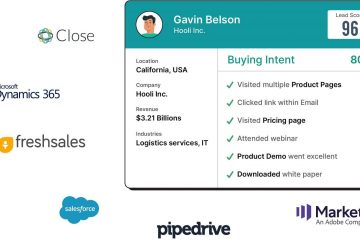Definitive Guide To Paid Search Advertising
Building your marketing presence organically takes a lot of time and resources. Paid search advertising, on the other hand, is one of the quickest and easiest ways to get your brand in front of your potential buyers.
For this reason, it is considered an effective tactic by marketers worldwide for increasing brand awareness and influencing sales opportunities. In fact, advertisers are projected to spend $190.5 billion on search advertising globally in 2024. With 53% of all website traffic coming from search engines, paid search provides businesses a great opportunity to snag prospective customers.
However, you may be thinking, why shouldn’t you try to organically increase your website’s traffic when it is free?
Here’s the thing. While search engine optimization (SEO) can eventually drive your website to the top of SERPs (if done right, of course), more and more businesses are getting themselves online today, which means there is a stiff competition all around. In case you are a startup or are launching a new product or service, ranking high on SERPs may take a while.
This is where paid search advertising turns out to be more effective. While there is a minimal investment you have to make, you can move up the rankings on SERPs like Google or Bing in record time — and as studies show, 46% of clicks go to the top three paid ads in the search results.
In this blog, we will discuss what paid search is. what its benefits are, and the key metrics that you should be measuring to determine the success of your paid search campaigns. We will also explore Google Ads, the predominantly popular paid ads platform. Furthermore, we will highlight the top paid search analytics tools (besides Google Analytics) that you should check out in 2024. Ready to take your paid search advertising to the next level? Let’s get started!
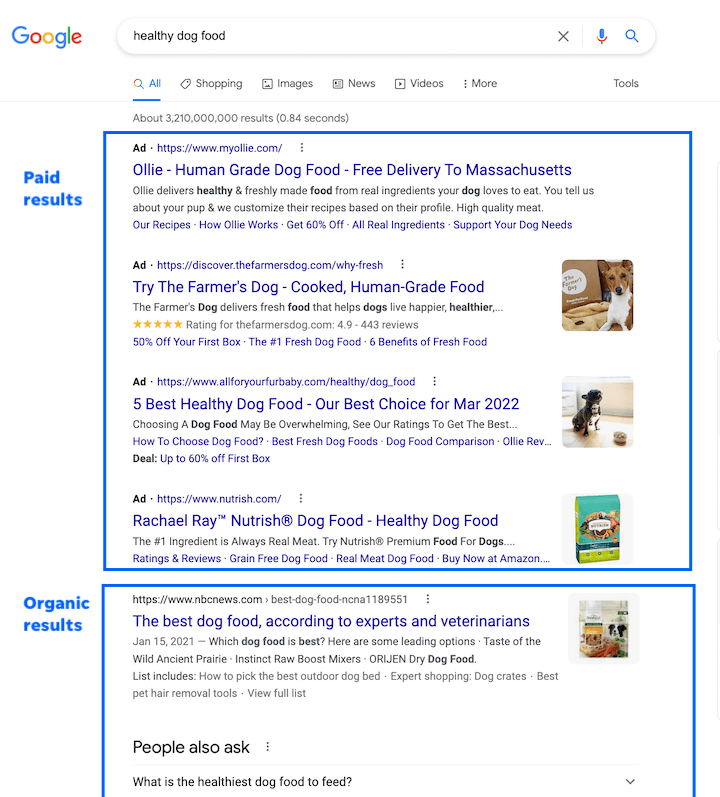
Image Source: Wordstream
What is Paid Search?
Paid search advertising is an effective digital marketing tactic for increasing website traffic, which enables businesses to compensate search engines to display their ads higher on relevant search engine results pages (SERPs).
Paid search results are the ones that appear at the top of SERPs like Google, with a little green box with the word “Ad” featured next to it.
Pay-Per-Click (PPC) advertising is the most popular type of paid search. Businesses who use PPC campaigns don’t have to pay anything until a user clicks on their advertisement. Owing to this, it is a cost-effective method of advertising that ensures potential customers are clicking on your ads.
The placement of your advertisement in SERPs is determined by a few key factors, such as:
- Keywords: These are phrases people search for that are relevant to your business. The number of keywords you use in your advertising and how frequently you use them can determine where your business ranks on the SERP.
- Bidding: Businesses can place bids on keywords associated with their brand, products, or services. Higher rankings are usually awarded to the highest bidders on the search results page.
- Ad Extensions: These include phone numbers and links to contact pages and other relevant information that businesses publish on their websites. Ad extensions can also impact the SERP rankings for your business.
- Quality of Ads and Landing Pages: Google also evaluates the usefulness and relevancy of your landing pages and assigns a Quality Score for your ads. This score can also affect the SERP rankings for your business.
There are some other factors in consideration, including the search keyword, time, place, competing advertisements or other search results, and type of device.
For newer online businesses in particular, paid search is one of the fastest ways to build visibility and draw clients. There are other benefits too, which we will cover in the next section.

Image Source: Innovel
How Effective is Paid Search Advertising?
According to Hubspot’s Annual State of Marketing Report, 63% of people have clicked on a Google ad before. So, it’s effectiveness is unquestioned. Well-designed, tailored advertisements not only make your advertising more effective but also perform better when combined with optimized landing pages.
Moreover, search engines like Google and Bing constitute one of the best ways businesses can reach their target audience online. Google handles more than 3.5 billion searches every day, indicating that search engine marketing, and consequently, paid search advertising, is likely to stay relevant for years to come. Your company showing up at the top of the results page is the main advantage of paid search marketing efforts, in addition to organic SEO placing your website on the first page.
Here are some more benefits of paid search advertising:
- Increased Visibility: Paid search advertising can propel your business to the top of search results instantly, compared to ranking your website organically, which will take some time and resources. As long as you are able to pay, it does not matter if you are a small new business or a big enterprise, you can show up to your target customers.
- Greater Reach Towards Target Audience: Businesses can target potential customers who are looking for their products or services and have a higher buying intent by conducting keyword research. You can also promote your selling factor right on the ad itself. For instance, a cosmetics brand is more likely to attract consumers who are looking for makeup products if they use paid search advertisements targeting a keyword phrase like “paraben-free makeup.”Bidding on keywords relevant to your business is a great way to reach your target audience. Moreover, you can target specific queries, thereby reaching the people already searching for products and services in your category.
- More Website Traffic: This correlates directly with increased visibility, i.e., you hardly have to wait to see an increase in website traffic with paid search ads compared to organically optimizing your website. This works best for startups looking to establish themselves in the market and businesses aiming to rank for certain organic terms that they presently don’t.Furthermore, paid search advertisements with focused strategies connect with customers who are specifically looking for what you have to offer, while weeding out those who require convincing to buy. This results in a higher volume of interested prospects visiting your website.
- Detailed Analytics: Search engines give marketers access to free real-time data and analytics so they can see exactly what their paid search dollars are bringing them and learn more about their prospects and campaigns. Analyzing the data from paid search campaigns, marketers can understand —
- Where a prospect is located geographically,
- What kind of device they are browsing on,
- Which pages on your website they viewed, and,
- How much time they spent on your website.You can use these details to continually optimize your campaigns and make sure your advertising money is being spent as efficiently as possible.
- Cost-Effectiveness: Paid search ads put you in control of how you are allocating your advertising budget. For instance, you might spend thousands of dollars on a billboard, but you will never know if your target audience is actually coming across your content. In contrast, if you invest the same amount of money on paid ads, you will be directly targeting customers in your target market who are already actively searching online for your products and services.This is where the cost-effective factor of paid search ads kicks in. Since a majority of search engines deploy a bidding model, the cost of advertisements majorly depends on the market. You will only pay $1.01 if the next highest bid is merely $1. Companies can alter their bid at any time and frequently end up paying less than their maximum bid amount. Moreover, research indicates that businesses make an average of $2 for every $1 they spend with Google Ads. This implies that paid search marketing is a fantastic choice for many types of organizations, ranging from local startups to multi-national conglomerates.
As illustrated above, paid search advertising has some great advantages, and if you want to try out paid ads after reading the aforementioned data, the following section is vital for you. In the next section, we will be looking at the key metrics you should be measuring to determine the success of your paid search campaigns.
Key Metrics for Paid Search Analytics
Make no mistake, paid search advertising will require you to make an investment, albeit a small one, from your own pocket. In light of this it is essential to measure whether your paid search dollars are bringing you a return on their investment. The following key metrics can help you realize the value of the paid search advertising approach and whether it is working for your business:
- Impressions: Impressions indicate the frequency with which your advertisement has been shown on a screen, whether on an app, a website inside a display network, or search engine results pages (SERPs).
An impression is recorded regardless of the user’s interaction with the advertisement. It helps in gauging how visible your advertisement is. An increase in impressions on your paid search ad may point to Increased brand awareness, which indicates that more people are seeing it. On the other hand, if your advertisement receives a lot of impressions but a few clicks, it might not be strong enough to motivate people to take action. - Click-Through Rate: Click-through rate is the percentage of viewers who actually clicked on your advertisement. In short, it displays the frequency with which users click on your advertisement each time it appears.A high click-through rate (CTR) shows that your advertisement successfully piques the interest of viewers and encourages them to learn more or make a purchase.To determine the CTR, you must divide the total number of clicks on your advertisement by the total number of impressions and then, multiply the result by 100 to obtain the percentage. The significance of a CTR is that it indicates how relevant and engaging your ad is for your target audience.
- Average Cost-Per-Click: When someone clicks on your advertisement, you typically pay a certain amount — this metric is your average cost-per-click or CPC. It is an essential paid search metric to know how much you spend on each website visitor.In general, lower CPCs are preferable as they increase your margins. But, CPC depends on keyword and competitive keywords will attract a higher CPC.You can find out the average CPC for your ad by dividing the entire cost of your clicks by the total clicks. The metric will be provided through the dashboard on all popular ad platforms.
- Conversion Rate: Conversion rate measures the frequency with which a click on your advertisement results in a desired action — like a purchase, sign-up, or download. It gives you the percentage of users who take any action towards conversion by clicking your ad.The conversion rate metric indicates the degree to which your advertisement is able to persuade viewers to do the desired action.A high conversion rate means that your landing page and advertisement are doing a good job of persuading people to take action. You can find out the conversion rate for your ad by dividing the entire number of conversions by the total number of ad interactions that may be linked to a conversion.
- Return on Ad Spend: Return on ad spend or ROAS is a measure of the revenue generated in lieu of the total amount of money you have spent running your paid search advertisement.
It essentially displays the profitability of your ad campaign and provides you with an estimate of your income generation for each dollar invested in your PPC advertising campaign.
You can determine ROAS by dividing the revenue from the advertisement by the entire cost of the advertisement. Your ROAS is 200%, for instance, if you invest $100 in an advertising campaign and bring in $200 in revenue.
Now that we have discussed the essential metrics, let’s talk about the platforms you will use. We will start by discussing Google Ads below, which as you might know, is the most popular paid search platform.
Exploring Google Ads — the Most Popular Paid Search Platform
It is a no brainer that Google Ads is the most used paid search advertising platform when you consider the fact the Google is the most popular search engine by a huge margin.
How Advertising Works On Google Search
Paid search advertisers must bid on keywords in order to have their advertisement shown, services provided, product listed, or video promoted on Google. The search engine also provides an option to display your search ads on videos, non-search websites (search partners), and mobile apps.
There are three steps:
- Choose the Right Keywords: Keywords align your advertisements with popular search queries. You can use broad match in conjunction with smart bidding to maximize the performance of Google’s AI and reach more relevant queries that are anticipated to meet your objectives.
- Set Accurate Bids with Google AI’s Smart Bidding: Machine learning is used in Smart Bidding to automatically set bids that maximize ROI, help you meet performance targets, and save time. You can also choose to do your bidding manually.
- Use Responsive Search Ads: Responsive search advertisements, can assist you in displaying the appropriate adverts to the appropriate users. Add elements to your advertising, such as photos and site links, to make them even more beneficial.
With Google handling over 99,000 search queries each second, there is a very high possibility that your advertisement will be seen by the people you want to reach, leading to a sale or other revenue opportunities. Both small businesses and Fortune 500 companies can benefit greatly from Google Ads. Using Google Ads, you can show your ad to one or both of Google’s networks — the Google Search Network that includes all the advertisements that show up on Google search results pages, including those for Google Shopping, Maps, Search, and its other search partners, and the Google Display Network that consists of all Google-partnered websites in addition to other Google properties like Gmail and YouTube.
The biggest drawback of using Google Ads though, is that Google continually rolls out new features to enhance its offerings, so any problem that seems to be a significant oversight or problem on Google’s end will usually be resolved in the future — sometimes even years later. For instance, Google introduced Enhanced Campaigns in 2013 and gave advertisers the ability to target individuals based on their location, device, and time of day. However, this update eliminated the ability for marketers to target tablet users differently from mobile and desktop users. Google users had to complain bitterly for years, before Google finally reinstated tablet bidding. Incidents like these made many marketers begin their search for better alternatives.
Moreover, getting access to detailed analytics about your search ads can be a little tricky with Google Analytics, the preferred partner of Google Ads. Google Ads has many limitations, such as data sampling (i.e., standardizing analytics data), insufficient compliance with EU data laws, and lack of customer support. These drawbacks drove marketers (especially those in b2B) to look for tools that provide better paid search analytics.
In the following section, we have highlighted some of the top paid search analytics tools of 2024, in addition to Google’s own Ad tools.
Top Paid Search Analytics Tools of 2024
Let’s jump straight to it! Here are the top paid search analytics tools you should definitely check out in 2024:
Google Tools
Google Ads has a robust set of tools to support paid search analytics. These include:
- Google Ads in-built reporting
Google Ads provides robust reporting capabilities, empowering advertisers to track and analyze the performance of their online campaigns with precision. The platform offers a comprehensive suite of reporting tools that enable users to measure key metrics such as clicks, impressions, conversions, and click-through rates. Through customizable dashboards and detailed reports, advertisers can gain valuable insights into the effectiveness of their ads, allowing for data-driven decision-making. Google Ads reporting also integrates seamlessly with Google Analytics, providing a holistic view of user behavior and engagement. Advertisers can segment data based on various parameters, including demographics, devices, and geographical locations, allowing for targeted analysis and optimization of campaigns. With real-time reporting features, advertisers can stay informed about campaign performance and make timely adjustments to enhance their overall advertising strategy. Overall, Google Ads’ reporting capabilities contribute significantly to the platform’s appeal, offering advertisers the tools they need to refine and optimize their online advertising efforts. - Google Trends
Google Trends shows the volume of searches for particular terms in relation to all searches on the search engine. It gives you a thorough picture of a keyword’s popularity over time and allows you to monitor seasonal variations and shifts in interest following national or local events.
Both SEM and SEO growth strategies make heavy use of keywords; however, marketers usually use Trends for SEO. With Google Trends, you may identify underutilized search phrases that could generate future traffic.Google Trends offers many features, such as showing fluctuations in keyword volume over a specific time period, identifying search queries with future potential, featuring historical, seasonal, and regional data, and finding relevant lookalike keywords for your products or services. The software also provides valuable insights into how current events are impacting organic and paid search behavior. - Google Keyword Planner
Google Keyword Planner is the most popular tool for researching relevant keywords to bid on for a paid search campaign. To get started, all you need is an active Google Ads account. You can begin using the software with a website URL or just foundation keywords. Once Google scans through this data, the user is given back relevant search terms.It takes time and effort to manually go through and choose the keywords that are relevant to your brand and the content you wish to promote in your paid search ad. Google Keyword Planner also offers forecasts in addition to historical stats on search volume. It also indicates the amount of competition for bids and displays the average search volume for each keyword. These metrics are essential for optimizing the performance of paid search ads and managing your campaign’s budget.
Furthermore, you can apply geographical and language filters to get back highly refined keyword results. Google Keyword Planner can also organize relevant keywords into ad groups for improved budget-friendliness. Not to mention, it integrates seamlessly with Google Ads.
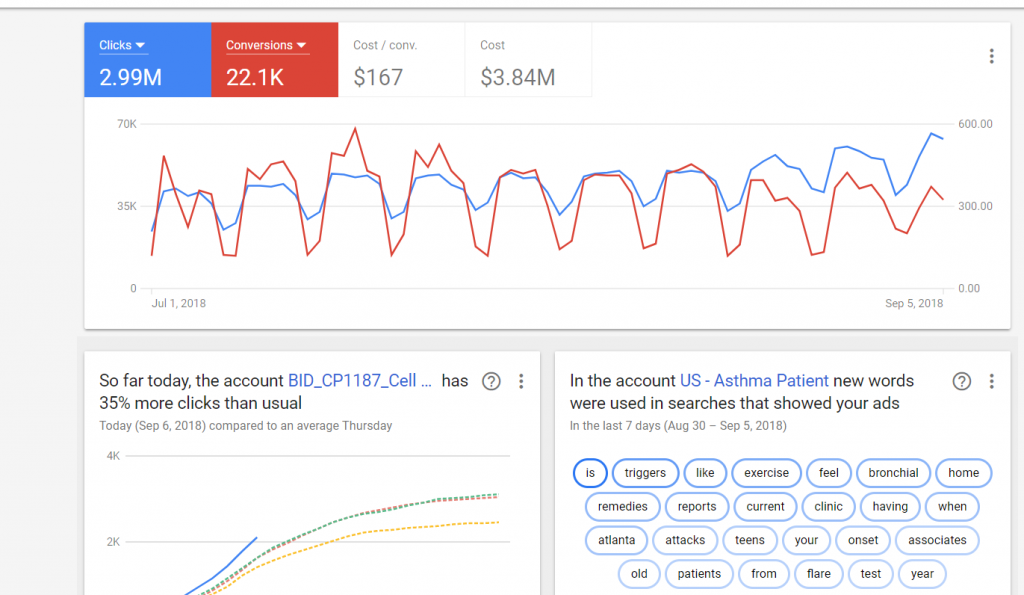
Image Source: Supermetrics
2. Salespanel
While analyzing traffic as a group can give you statistical data, if you want to gain granular insights into who clicked on your ad, Salespanel can be the perfect tool for you.
Salespanel tracks your website visitors in real-time and assign them the tag of an “Account” (useful for B2B as it identifies the company a visitor is from) or an “Anonymous Visitor”, until they sign up. When they sign-up, the session data is connected to the individual lead. So, you will know which keyword a lead searched for before they signed up.
You can further segment people based on keywords or ad campaigns using the segmentation tool and start monitoring your ad performance. Salespanel also records the amount of time a lead spends on each page of your website as well as the number of pages they view.
Salespanel uses ValueTrack parameters to track which campaigns your leads are from, which ad they viewed, and what keyword they searched for when they click on Google or Bing ads. These leads can be traced back to their origin platform using their UTM characteristics. Now, a UTM parameter is a string appended to the end of your call-to-action URL. By including ValueTrack settings in your Google Ads, you may monitor visitors originating from your ads. Learn more
As soon as you configure tracking and traffic from your ads flooding in, your Salespanel account will start logging in the analytics data. With features like Segments and Reports, it is simple to identify your best-performing keywords or campaigns.
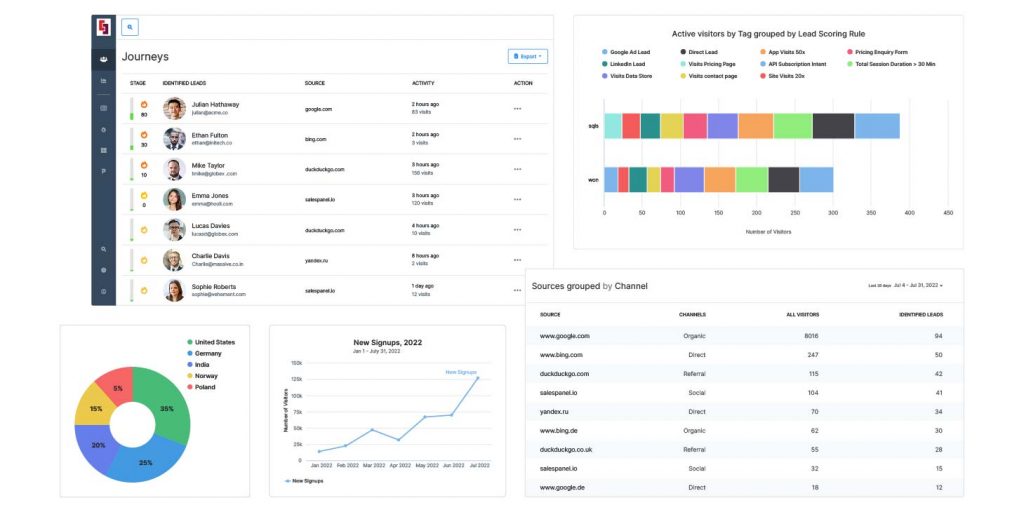
3. Google Analytics 4
Google Analytics is the official Google Ads reporting tool, excellent tool for custom reporting, conversion tracking, and demographic data. Google Analytics provides granular information about paid search metrics like cost per click and return on investment, for instance. This ties back directly to each dollar you invest, the quantity of clicks you receive, and the total amount of money you make from Google Ads.
You may also use this software for Google advertising campaign analysis, to find out the demographics of the people who are interacting with your advertising. This can help you tailor your ads to appeal to particular demographics. Google Analytics also allows you to monitor conversions across forms and landing pages. You may track actions like downloads and video plays to gain insight into how users of paid search interact with your website and find ways to increase user engagement.
While Google Analytics is undoubtedly among the greatest PPC tools, it also provides insightful data on organic traffic, social media, and referrals to assist you in strategizing the expansion of your website’s reach organically. It is easy to set up, free and accessible for small business owners, and offers detailed audience insights for engagement metrics, that can help you improve the performance of your ads and landing pages.

Image Courtesy: Optimize Smart
4. SpyFu
Using web scraping, SpyFu investigates the marketing methods of your rivals to identify their most profitable keywords and most effective landing page designs.
SpyFu comes with an Ad History tool which displays copy performance. You can use it to evaluate existing ad campaigns, identify exactly what worked for them, and draw inspiration for your own ad content from ads that have already proven effective.
The software also comes with general SEO capabilities to help with rank tracking and backlink research. SpyFu offers some more features in its free version, including streamlined keyword research and competitor analysis, data export for collaboration, and more. A basic plan subscription starts at $39 per month, with discounts for yearly payment.

5. Semrush
Semrush is one of the best PPC tools, equipped with features to handle all the different aspects of paid search advertising.
Its Advertising Research tool allows you to examine competitors’ best-performing content and determine the keywords they are focusing on, while its Keyword Magic feature finds appropriate keywords by filtering based on parameters like search traffic and cost per click. Paid search position tracking is another feature of the software that helps to continuously track your ad position and make optimizations that ensure greater success.
Semrush also allows users to conduct a keyword gap analysis against your competitors. With the Keyword Gap feature, you can find cost-effective search terms your competitors may have missed. Semrush also offers advanced features for removing duplicate and irrelevant keywords. You can further easily import Google Ads into Semrush to track their performance. However, the free version of Semrush only permits 10 free searches per day, so you must plan what data you wish to access in advance and be careful where you click.
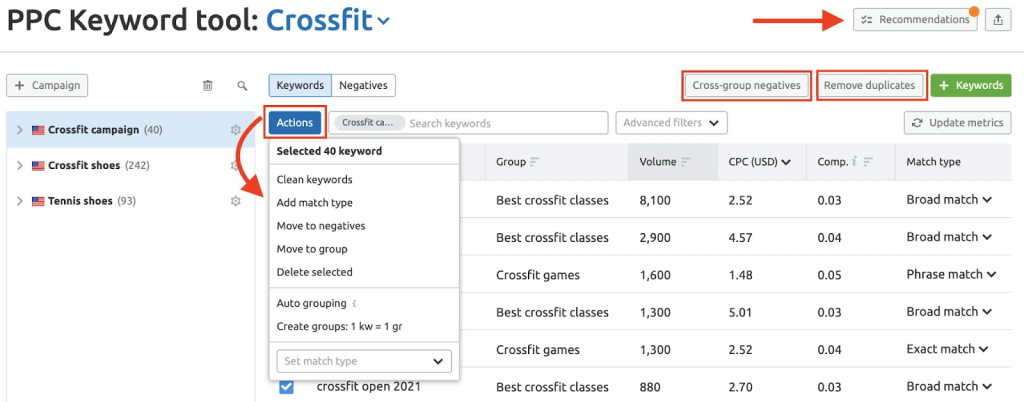
6. Ahrefs
While Ahrefs offers a robust SEO toolkit and most marketers mainly use to it monitor and gain insights into organic web traffic, it provides powerful features for analyzing paid search traffic too. You may obtain a thorough understanding of your paid traffic sources using Ahrefs, including the most popular paid sites and effective keywords that generate traffic.
The Paid Search Report feature gives you important data about how well your paid advertising efforts are doing. It enables you to monitor the return on investment (ROI) of your paid traffic initiatives, evaluate the effectiveness of your sponsored keywords, and pinpoint high-performing pages. Through the analysis of click-through rates, impressions, and expenses related to particular keywords, you may enhance the performance of your advertising campaigns.
With Ahrefs you can analyze which of your website pages are performing best. You can also do the same for your competitors’ website pages to gain insights into their paid search strategies and find potential opportunities for your own campaigns.
Ahref’s is also useful for identifying high-performing paid keywords for businesses to bid on. In the Paid Search Report, you can find relevant keywords with high CPC and CTR. From there, you can consider the competitiveness of the keywords by assessing their search volume and difficulty score. Ahrefs’ Keyword Explorer tool can also help you explore related and long-tail keywords that have the potential to drive targeted paid traffic. Besides this, Ahrefs supports businesses in tracking the return on investment (ROI) on their paid advertisements by evaluating top-performing keywords and ad placements, empowering you to make data-driven choices for the best outcomes.
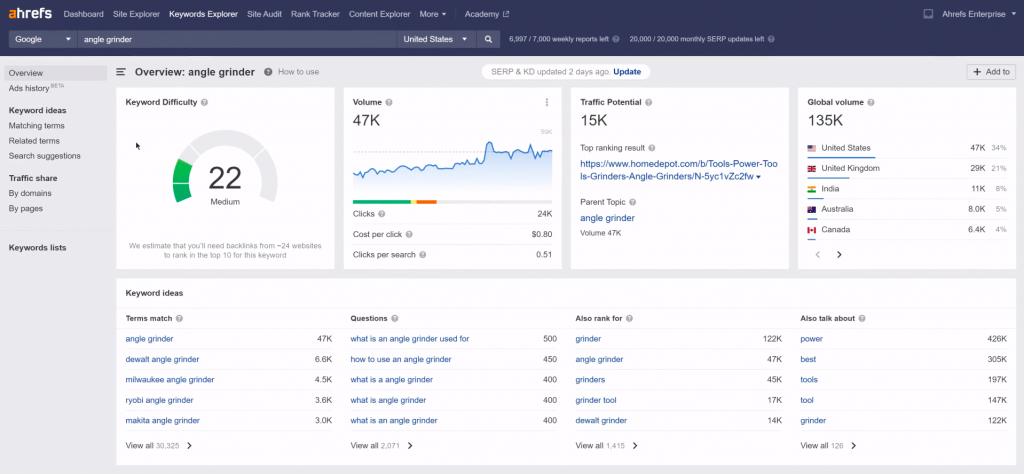
Final Thoughts
Paid search advertising is perfect for a startup’s go-to-market (GTM) strategy because it can shoot your brand up the SERP rankings and extend the reach of your business, specifically to your target audience. It may involve spending a small amount of money on your part, but if you use the appropriate paid search tools to measure the right paid search metrics that help you optimize the overall performance of your ad campaigns, you can be assured that your ROI will far exceed your initial investment.
If you are wondering which paid search analytics tool would make your paid search advertising efforts the most effective, we would like to recommend Salespanel. Salespanel can help you track leads from your search ad campaigns, whether you publish them on Google or Bing. Using this software can further help you qualify leads based on buyer intent keywords, segment leads derived from an ad using pre-existing qualification criteria, and send targeted nurturing campaigns based on lead interests. Check out Salespanel with its 14-day free trial today!
Sell more, understand your customers’ journey for free!
Sales and Marketing teams spend millions of dollars to bring visitors to your website. But do you track your customer’s journey? Do you know who buys and why?
Around 8% of your website traffic will sign up on your lead forms. What happens to the other 92% of your traffic? Can you identify your visiting accounts? Can you engage and retarget your qualified visitors even if they are not identified?
